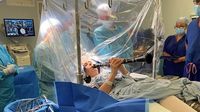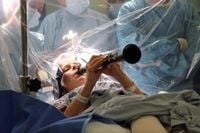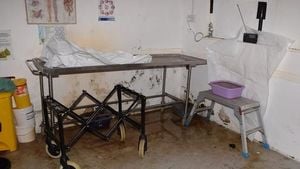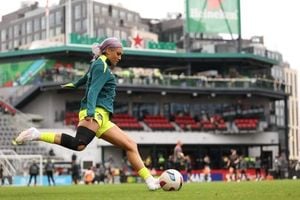On October 21, 2025, the operating theatre at King’s College Hospital in London witnessed an extraordinary moment: Denise Bacon, a 65-year-old retired speech and language therapist from Crowborough, East Sussex, played her clarinet while surgeons worked inside her brain. This wasn’t a musical interlude for morale—it was a bold, real-time test of a complex procedure designed to relieve the debilitating symptoms of Parkinson’s disease.
Bacon’s journey with Parkinson’s began in 2014. Over the years, the progressive neurological disorder, known for causing tremors, slowness, rigidity, and muscle stiffness, gradually eroded her ability to walk, swim, dance, and play her beloved clarinet. Once an active member of the East Grinstead Concert Band, she was forced to give up music five years ago as her condition worsened. But on that October day, hope—and music—returned to her fingers.
The treatment Bacon underwent is called deep brain stimulation (DBS), a surgical procedure often reserved for patients with movement disorders that don’t respond well to medication. According to The Independent, DBS involves implanting electrodes into targeted areas of the brain that control movement. These electrodes are then connected to a pacemaker-like pulse generator, usually implanted in the patient’s chest, which delivers continuous electrical impulses to help manage symptoms.
The operation itself is a feat of precision. As Professor Keyoumars Ashkan, the neurosurgeon who led Bacon’s procedure, explained, “Holes half the size of a five pence piece were made in Denise’s skull after a frame with precise coordinates was placed on Denise’s head, acting as a sat nav to guide us to the correct positions within the brain to implant the electrode.” The process is painstaking, but the payoff can be immediate and dramatic.
What set Bacon’s surgery apart was her active participation. She remained awake throughout the four-hour operation, her scalp and skull numbed by local anesthetic. This allowed the surgical team to monitor her symptoms in real time, adjusting the stimulation and observing the effects instantly. In a remarkable demonstration, Bacon brought her clarinet into the operating theatre. As the electrical current was delivered to the electrodes, her right hand—previously stiff and unresponsive—began to move with newfound ease.
“I remember my right hand being able to move with much more ease once the stimulation was applied, and this in turn improved my ability to play the clarinet, which I was delighted with,” Bacon told Sky News. Her joy was palpable. “I’m already experiencing improvements in my ability to walk, and I’m keen to get back in the swimming pool, and on the dance floor to see if my abilities have improved there.”
For the surgical team, the transformation was just as striking. Professor Ashkan recounted, “Once the electrodes were in place on the left side of Denise’s brain, the current was switched on and an immediate improvement was noted in hand movements on her right side. The same happened on her left side when we implanted electrodes on the right side of her brain.” He added, “As a keen clarinettist, it was suggested Denise bring her clarinet into the operating theatre to see whether the procedure would improve her ability to play, which was one of Denise’s main goals for the surgery. We were delighted to see an instant improvement in her hand movements, and therefore her ability to play, once stimulation was delivered to the brain.”
DBS is not a cure for Parkinson’s, and it does not halt the disease’s progression. However, as BBC News notes, it can significantly relieve symptoms such as tremor, stiffness, and slowness of movement, improving quality of life for patients who no longer respond well to medication. The technology has evolved over the years, and Bacon opted for a rechargeable type of pulse generator battery implanted in her chest. This device can last up to 20 years before needing replacement and is capable of automatically adjusting the level of stimulation based on her brain activity.
“Deep brain stimulation is one of the most effective, evidence-based and long-lasting therapies to control the motor symptoms of Parkinson’s disease,” Professor Ashkan emphasized in a statement to The Guardian. “Modern advances in DBS technology are now allowing us to personalise the therapy to the needs of our patients, with a positive impact on their quality of life.”
The decision to undergo such an invasive procedure is never taken lightly. DBS requires drilling into the skull and precise navigation to avoid damaging critical brain structures. The surgery is typically reserved for patients whose symptoms are severe and who have exhausted other treatment options. Bacon’s case, however, highlights the potential for DBS not just to restore basic functions but to rekindle passions and hobbies that give life its meaning.
For Bacon, the improvement was immediate and profound. “I’m already experiencing improvements in my ability to walk, and I’m keen to get back in the swimming pool, and on the dance floor to see if my abilities have improved there,” she said, echoing her hopes for a return to activities she once loved. The operation has given her a new lease on life, and she’s eager to see just how far her recovery will go.
Parkinson’s disease remains a formidable challenge. According to the NHS, the condition affects around 145,000 people in the UK alone, with symptoms that worsen progressively over time. While DBS is not suitable for everyone, it represents a beacon of hope for those whose quality of life has been severely compromised. The procedure’s success depends on careful patient selection, expert surgical technique, and ongoing management of the device.
Bacon’s story has resonated widely, not just for its medical significance but for its deeply human dimension. The image of a woman reclaiming her music, even as surgeons work inside her brain, is a vivid reminder of the resilience and ingenuity that modern medicine can inspire. As Professor Ashkan and his team continue to refine DBS and other therapies, patients like Denise Bacon stand as living proof of what’s possible when science, skill, and determination come together.
With her clarinet in hand and a new rhythm in her step, Bacon is ready to embrace the next chapter—one note, one dance, and one swim at a time.





